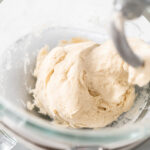Most doughs typically need about 5–7 minutes in a stand mixer on medium-low speed. This can vary on the type of dough and the recipe you’re using. Here are some more details.
Softer doughs (cookies or cakes): around 2–3 minutes
Bread Dough (Basic Yeast Dough): 5–7 minutes
Pizza Dough: 6–8 minutes
Enriched Doughs (e.g., Brioche): 8–10 minutes
Whole Wheat Dough: 5–7 minutes (less gluten requires less kneading)
Always check the dough’s texture as it mixes. It should come together in a ball and feel slightly tacky but not sticky. To check if the dough is done, do the windowpane test. Take a small piece of dough and stretch it gently. It should form a thin, translucent sheet without tearing.
Signs Your Dough is Overkneaded
Overkneading can happen when the dough is mixed for too long or at too high a speed. Here’s how to tell:
- Overkneaded dough becomes overly elastic and tears instead of stretching when you pull it.
- The dough may feel stiff and difficult to work with.
- You ended up with dense bread with minimal rise after baking.
- Your baked goods are dry or crumbly.
Signs Your Dough is Underkneaded
Underkneaded dough hasn’t developed enough gluten to hold its structure. Here’s what to look for:
- The dough doesn’t come together into a smooth ball and feels very sticky.
- If you try to stretch it, it breaks easily instead of stretching into a thin sheet.
- The dough feels dense or heavy instead of light and airy.
How to Make the Perfect Dough: Step-by-Step Guide
Step 1: Measure out all your ingredients using a digital scale.
Step 2: If your recipe uses active dry yeast, dissolve it in warm water (around 100–110°F) with a pinch of sugar. Let it sit for 5–10 minutes until it’s frothy. For instant yeast, you can skip this step and mix it directly with the dry ingredients.
Step 3: In the bowl of your stand mixer, combine the flour, salt, and any other dry ingredients. Use the paddle attachment or a spoon to give them a quick mix.
Step 4: Slowly pour in the water, yeast mixture (if using), and any other liquids like oil or milk. Start mixing on low speed using the dough hook attachment.
Step 5: Once the ingredients are combined, increase the mixer speed to medium-low. Knead for 5–7 minutes. Stop occasionally to check the dough. It should form a smooth ball and pull away from the sides of the bowl. The dough should feel slightly tacky but not sticky. If it’s too dry, add a teaspoon of water at a time. If it’s too wet, sprinkle in a little flour.
Step 6: Place the dough in a lightly oiled bowl, turning it to coat all sides. Cover with a damp cloth or plastic wrap. Let it rise in a warm spot until it doubles in size. This should take 1–2 hours.
Step 7: Gently punch the dough to release excess air. Turn it out onto a floured surface and shape it as needed for your recipe.
Step 8: Place it in your pan, and let it rise again for 30–60 minutes until it’s puffy.
Step 9: Follow your recipe’s instructions for baking or cooking.
Summary
Kneading dough in a stand mixer typically takes 5–7 minutes, but always pay attention to the dough’s texture and elasticity. The dough should be smooth, slightly tacky, and elastic.
Looking for the perfect stand mixer to make your baking effortless? MisterChef stand mixers are powerful, durable, and designed to give you consistent results every time. Shop with us today.







